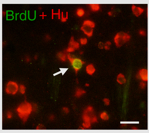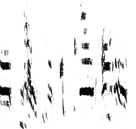Lab Research

Our lab is interested in the function and regulation of new neurons born in the post-embryonic brain, particularly in adulthood. Although we have known about adult neurogenesis for decades, the relationship between new neurons and behavior remains unclear. To study this brain-behavior relationship, we are focusing on new neurons that are incorporated into the motor pathway underlying the production of learned song motor patterns in songbirds.
New neurons are born in the subventricular zone of the lateral ventricles and migrate throughout the telencephalon where they become incorporated into existing networks. One region that incorporates new neurons is the nucleus HVC, which is a component of the song motor pathway and is one of our regions of interest. After new neurons reach HVC, many die within their first month of cell life. After this initial culling period, these young HVC neurons can live for many months before being replaced. One question we are interested in is whether behavioral factors may influence the survival of new neurons.
Current Projects

One idea we are testing is that the quality of the songs that birds are singing may influence the survival of neurons that have been recently incorporated into the song motor pathway. Alternatively, neuronal survival may be determined by the age of the neuron, cumulative activity levels, or other intracellular variables. To study the effect of song feedback on new neuron survival, we alter song production and assess the impact of manipulations on the number of new neurons in song system regions. Specifically, we birth-date new cells with the mitotic marker bromodeoxyuridine (BrdU). Then we alter song quality by injecting the vocal muscles of the syrinx with botulinum toxin (botox(r)) which results in a temporary, partial paralysis of the sound-producing muscles. Birds continue to sing, but the acoustic structure of the song is altered. We then count the numbers of immunocytochemically labeled cells which indicate BrdU and also neuron-specific proteins. Finally, we compare the degree of song structure distortion with the rates of survival of new neurons in HVC and also compare the number of new HVC neurons between botox-treated birds and non-treated controls. Recent data reveals a striking correlation between the degree of song distortion and the numbers of new neurons maintained in HVC at 4 months post-birthdating. This is an exciting finding which suggests that the survival of new neurons may be influenced by song related behavioral feedback.
Another project focuses on the relationship between new neurons and dying cells. In this work we are looking at whether distorted song feedback leads to an increase in apoptotic cell death of HVC neurons. By adjusting the times at which we birth-date new cells and stain for dying cells, we are trying to learn more about the relationship between new and old cells in the process of neuron replacement.